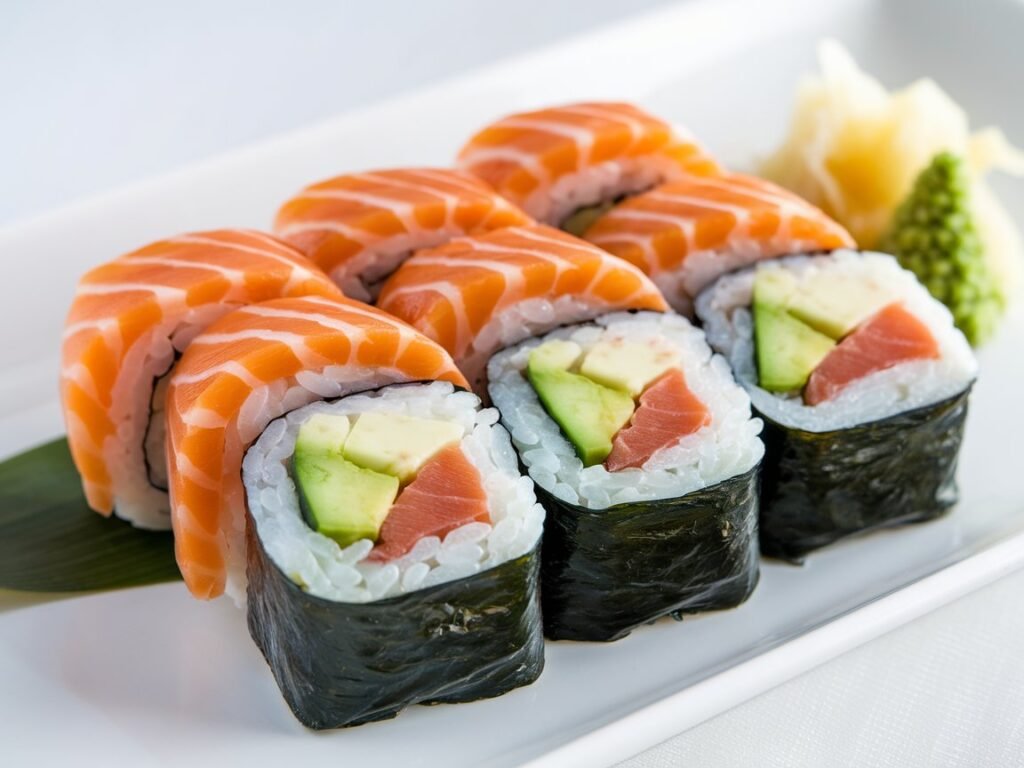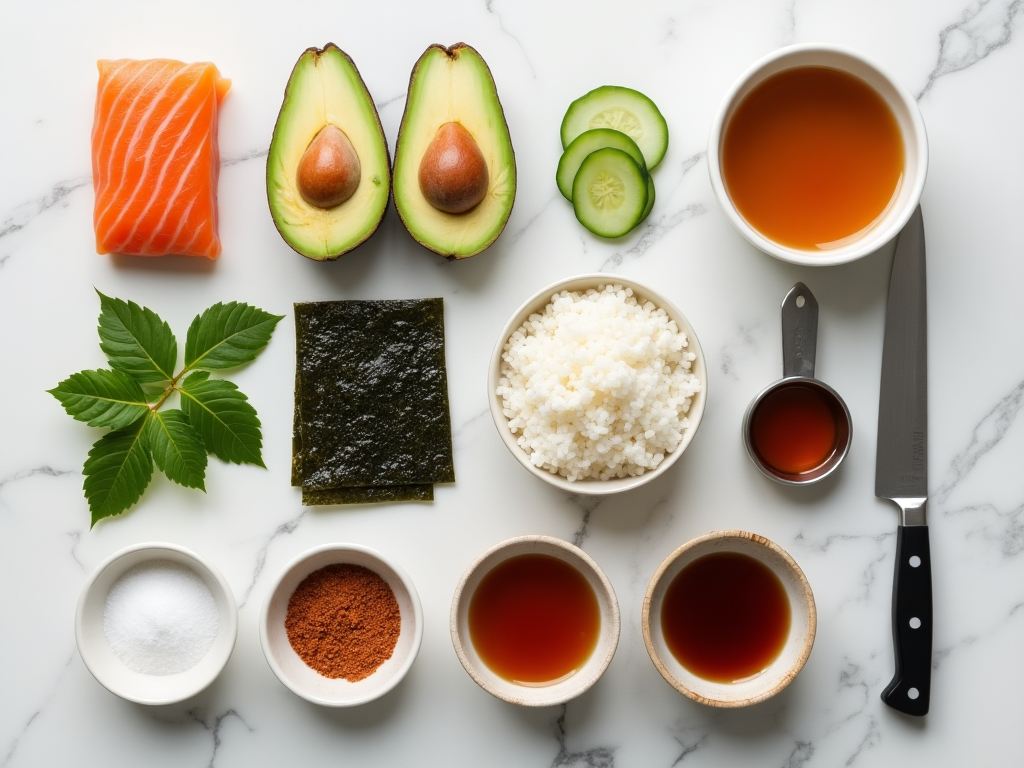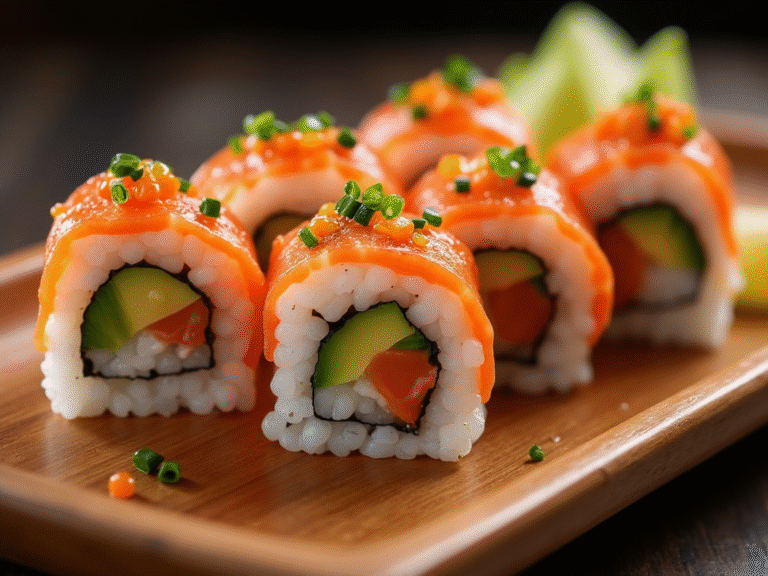Maki Sushi Recipe | Easy and Delicious Homemade Sushi
Maki Sushi Recipe: Fresh, Flavorful, and Easy to Make
1. Introduction
If you’ve ever eaten sushi at a restaurant, you know how delicious and satisfying it can be. But what if I told you that you can make sushi right in your own kitchen? Maki Sushi, or sushi rolls, are one of the easiest and most fun types of sushi to make at home. With just a few simple ingredients and a little practice, you can create restaurant-quality sushi in no time!
Why You’ll Love This Recipe
Maki sushi is a perfect balance of fresh ingredients, tender rice, and the crunch of fresh vegetables or fish. What makes this dish so amazing is that it’s customizable—you can choose the fillings, add extra toppings, and adjust the flavor according to your taste. Whether you prefer the classic combination of salmon and avocado or you want to try something different like cucumber or crab, this recipe is versatile and easy to follow. Plus, making sushi at home is a fun activity to do with friends or family!
In this article, I’ll guide you through the process of making perfect Maki Sushi, explain each ingredient, and share tips on how to roll your sushi tightly and evenly. You’ll be a sushi master in no time!
2. Ingredients Breakdown
Making Maki Sushi requires just a few basic ingredients, most of which you can find at your local grocery store or an Asian market. Here’s a breakdown of what you’ll need:
- Sushi Rice (2 cups):
Sushi rice is short-grain rice that is sticky and perfect for rolling. It has a slightly sweet flavor due to the rice vinegar added to it. When preparing sushi, it’s essential to use sushi rice because it has the perfect texture to stick together and hold the shape of the roll. - Nori Sheets (5 sheets):
Nori is a type of seaweed that is used to wrap the sushi rolls. It’s slightly crispy and adds an oceanic flavor to the rolls. You can find nori sheets in most grocery stores or specialty Asian markets. Make sure to use roasted nori for the best flavor and texture. - Fresh Fish (4 oz of salmon or tuna):
Fresh fish like salmon or tuna is a traditional filling for Maki Sushi. Make sure the fish is sushi-grade, which means it’s safe to eat raw. If you prefer not to use raw fish, you can substitute with cooked options like shrimp or crab. - Avocado (1 ripe):
Avocado adds a creamy texture and a subtle, rich flavor to the sushi rolls. It’s a perfect contrast to the freshness of the fish and the crunch of the cucumber. Use a ripe avocado for the best texture. - Cucumber (1 medium):
Cucumber is used for its crisp texture and refreshing taste. It adds crunch to the sushi rolls and balances the creamy avocado and soft rice. - Rice Vinegar (2 tbsp):
Rice vinegar is mixed with sugar and salt to season the sushi rice. It gives the rice a tangy flavor that complements the freshness of the fish and vegetables. - Sugar (1 tbsp):
Sugar is combined with rice vinegar to season the sushi rice and create a balanced flavor. - Salt (½ tsp):
Salt enhances the flavor of the sushi rice and the fillings, making sure every bite is perfectly seasoned.
Substitutions and Dietary Preferences:
- Vegetarian Option: Omit the fish and use more avocado, cucumber, or even carrot for a vegetarian sushi roll.
- Gluten-Free: Ensure the soy sauce you use is gluten-free. Most nori sheets are naturally gluten-free, but check the label to be sure.
- Non-Dairy: This recipe is already dairy-free, but if you like, you can add some vegan mayo or avocado for extra creaminess.
3. Step-by-Step Instructions
Follow these steps to make your perfect Maki Sushi:
- Prepare the Sushi Rice:
Rinse the sushi rice under cold water until the water runs clear. Cook the rice according to the package instructions. Once cooked, transfer the rice to a large bowl and mix with the rice vinegar, sugar, and salt while the rice is still warm. Let the rice cool to room temperature before using it for the rolls. - Prepare the Fillings:
While the rice is cooling, slice the fish, avocado, and cucumber into thin strips. You want all the fillings to be long and thin to make the rolling easier and the rolls more uniform. - Assemble the Sushi Mat and Nori:
Lay a bamboo sushi mat on a flat surface, and place a sheet of nori with the shiny side facing down. If you’re using a bamboo mat, be sure to cover it with a layer of plastic wrap to avoid sticky rice from getting stuck to the mat. - Spread the Rice:
Wet your hands with a little water (this prevents the rice from sticking to your hands). Take a small amount of sushi rice and gently spread it over the nori sheet, leaving about an inch of space at the top to seal the roll. Press the rice down gently to make an even layer. - Add the Fillings:
On top of the rice, place a few strips of your chosen fillings—fish, avocado, and cucumber—in a straight line across the center of the rice. - Roll the Sushi:
Starting from the bottom, use the sushi mat to gently roll the sushi up, applying a little pressure to form a tight roll. Once you reach the top edge of the nori, wet it with a little water to help seal the roll. - Slice the Roll:
Use a sharp knife to slice the roll into 6-8 pieces. Clean the knife between each slice to keep the edges clean and neat. - Serve and Enjoy:
Arrange the sushi pieces on a plate, and serve with soy sauce, pickled ginger, and wasabi on the side. Enjoy your homemade Maki Sushi!
4. Tips and Variations
- Make It Spicy: Add a bit of sriracha mayo or spicy mayo to the filling for a little heat. You can mix mayonnaise and sriracha sauce to create your own spicy mayo.
- Use a Rolling Mat: A bamboo sushi mat is the best tool for rolling your sushi tightly and evenly. If you don’t have one, you can use a clean kitchen towel or your hands, but the mat gives better results.
- Add a Crunchy Topping: For extra crunch, top your sushi with crispy onions, tempura flakes, or sesame seeds.
- Change the Protein: If you’re not a fan of raw fish, you can use cooked shrimp, grilled chicken, or even vegetarian options like avocado, tofu, or tempeh.
5. Serving Suggestions
Maki Sushi is a versatile dish that can be served in a variety of ways:
- Side Dishes: Serve with miso soup, edamame, or a seaweed salad for a complete meal.
- Garnishes: Top your rolls with pickled ginger and wasabi for extra flavor. A sprinkle of sesame seeds or nori flakes can add a nice finishing touch.
- Pairing Ideas: Maki sushi pairs beautifully with a cold sake or a crisp, refreshing green tea. For a non-alcoholic option, try sparkling water with a slice of lemon.
6. Storage and Reheating Instructions
- In the Fridge: Sushi is best enjoyed fresh, but you can store leftover rolls in an airtight container in the fridge for up to 24 hours. Keep in mind that the texture of the rice may change slightly when refrigerated.
- Freezing Sushi: Freezing sushi is not recommended, as the rice and fish will lose their texture and quality once thawed.
Reheating Instructions:
It’s best to enjoy sushi fresh, but if you need to store it, avoid reheating it. Instead, enjoy the leftovers cold.
7. Recipe Notes
- Can Be Prepped Ahead of Time: Prepare the sushi rice and fillings in advance to save time on the day you’re making the sushi. The rice can be made a day ahead and stored in the fridge.
- Best with Fresh Ingredients: For the best flavor and texture, use the freshest fish and vegetables possible. Sushi is all about freshness!
- Optional Equipment: While a bamboo sushi mat is recommended for easy rolling, it’s not essential. You can still make sushi by hand, though it might take a little more practice to get the rolls tight.
8. Nutrition Information (Per Serving)
| Nutrient | Amount per Serving |
|---|---|
| Calories | 250 |
| Fat | 10g |
| Saturated Fat | 1g |
| Carbs | 28g |
| Sugar | 5g |
| Fiber | 5g |
| Protein | 9g |
| Sodium | 300mg |
| Cholesterol | 30mg |
| Calcium | 60mg |
| Iron | 2mg |
Nutrition information is an estimate and may vary based on specific ingredients used.
9. Recipe Card Summary
- Course: Main
- Cuisine: Japanese
- Servings: 2-4
- Prep Time: 30 minutes
- Cook Time: 0 minutes
- Total Time: 30 minutes
Ingredients:
- 2 cups sushi rice
- 5 sheets nori
- 4 oz sushi-grade fish (salmon or tuna)
- 1 ripe avocado
- 1 cucumber
- 2 tbsp rice vinegar
- 1 tbsp sugar
- ½ tsp salt
Instructions:
- Prepare the sushi rice and let it cool.
- Slice the fish, avocado, and cucumber into strips.
- Lay nori on a bamboo mat and spread with rice.
- Add fish, avocado, and cucumber as fillings.
- Roll tightly and slice into pieces.
- Serve with soy sauce, pickled ginger, and wasabi.
Notes: You can add extra toppings like sesame seeds, tempura flakes, or spicy mayo.
10. Health Benefits
- Sushi Rice: High in fiber and low-fat, sushi rice provides energy without the heaviness of many other carbs.
- Fish: Rich in omega-3 fatty acids, fish like salmon or tuna are great for heart health.
- Avocado: Packed with healthy fats, avocado supports skin health, improves digestion, and provides a rich, creamy texture.
11. Suggested Sauce
Serve your Maki Sushi with a side of soy sauce, spicy mayo, or a tangy teriyaki sauce for extra flavor. The dipping sauce is essential for bringing out the subtle flavors of the rice and fillings.
12. Avoid These Mistakes
- Overstuffing the Roll: Keep the fillings light to ensure that the roll stays tight and doesn’t fall apart.
- Not Wetting Your Hands: Wet your hands before handling the rice to avoid it sticking to your fingers.
- Not Using Sushi-Grade Fish: Always ensure that your fish is sushi-grade to avoid foodborne illnesses.
13. FAQs
- Can I use cooked fish instead of raw fish?
Yes, you can use cooked shrimp, crab, or even grilled chicken if you prefer not to eat raw fish. - Do I need a sushi mat?
While a bamboo mat makes rolling easier, you can also roll the sushi by hand using a clean towel or just your fingers. - Can I make sushi without fish?
Yes, you can make a vegetarian sushi roll with avocado, cucumber, carrot, and other vegetables. - How do I store leftover sushi?
Store leftover sushi in an airtight container in the fridge for up to 24 hours. - Can I make sushi without rice vinegar?
Rice vinegar is essential for seasoning the sushi rice. If you don’t have it, you can substitute with a little lemon juice or apple cider vinegar. - How do I keep the sushi from being too sticky?
Wet your hands when handling the rice, and avoid pressing it down too hard when spreading it on the nori.
14. Final Thoughts
Making Maki Sushi at home is an enjoyable and rewarding experience. With fresh ingredients and a little practice, you can create delicious rolls that rival your favorite sushi restaurants. I hope this recipe helps you master the art of sushi rolling—let me know how it turns out in the comments below!









